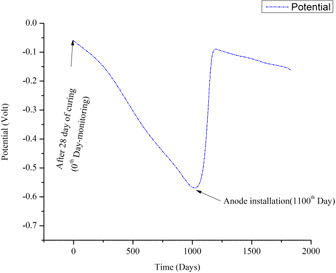ABSTRACT
In this study, steel rebar corrosion owing to chloride intrusion was evaluated in 5-year marine environment. Seawater is used as the mixing water for the concrete, and the specimens were completely immersed in seawater over 5-year study period. The study was conducted in two phases: Phase 1 was the first 3-years, and the concrete was allowed to continue its chloride reaction along with the rebar, and the rebar was allowed to corrode without any external protection; constant monitoring through half-cell potential and destructive tests, such as rebar diameter loss, were measured to track the corrosion level. After 23% of dimentional loss in rebar due to corrossion, cathodic protection is activated through the control system installed. The cathodic protection occurred over a period of 2 years, which is phase 2 of this study; during this phase, the half-cell potential values and current density were measured for the full 2 years. The bimetallic corrosion system reduces the steel rebar corrosion. Hence, zinc acting as the sacrificial anode provides protection to the steel rebar. The half-cell potential and current density values showed that the sacrificial anode provided efficient cathodic protection, thereby reducing corrosion and failure of the steel bar.
Keywords:
Zinc; Corrosion; Chloride; Cathodic protection; Galvanized anode

 Performance of zinc sacrificial anode in reinforced cement concrete members under chloride intrusion and marine environment exposure
Performance of zinc sacrificial anode in reinforced cement concrete members under chloride intrusion and marine environment exposure Thumbnail
Thumbnail
 Thumbnail
Thumbnail
 Thumbnail
Thumbnail
 Thumbnail
Thumbnail
 Thumbnail
Thumbnail
 Thumbnail
Thumbnail






